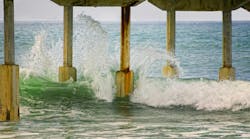In the modern age of commercial development, low impact designs not only are possible, but often are required by zoning ordinances. What once was considered “green” now is the standard. Developers are pressed to create projects that not only satisfy a commercial need, but also address the aesthetic and environmental concerns of regulatory boards and civic leaders.
To facilitate this evolution in thinking and changes in the regulatory environment, storm water management tools are needed to bring what is possible on paper into the real world. Trying to meet modern requirements with outdated systems and procedures is difficult, if not impossible.
One way modern requirements can be met is through underground storm water management systems. The ability to store runoff from a site underground, with pollution abatement and replication of natural hydrology integral to the design, is critical to the spirit of low impact development.
In general, loss of land to retention and detention ponds not only is costly, but in many cases not possible. Underground solutions can be more economical, safe and aligned with the new sense of low impact development practices.
A case in point of how the new technologies can deliver on the low impact promise is the Michigan State Police (MSP) Training Academy in Dimondale, Mich. An upgrade to the facility was required to meet the MSP’s training needs, as well as to address long-standing site issues.
A History of Problems
The state police training building historically had been plagued with flood conditions at its basement level, in part from storm sewer surcharge from a nearby state-owned complex and in part from its own runoff. An existing pump station, built as part of the original construction, was unable to keep pace with runoff experienced as nearby land use changed, causing the detention pond to overflow during heavy precipitation events. Because the project team could not modify the nearby state-owned site, it had to design a system that could attenuate all the runoff from the training facility and still have excess capability to handle the flows coming from nearby lands. To add to the challenge, the storm water system had to fit into a relatively small footprint to accommodate existing infrastructure and site constraints.
Underground Solution
Developers were able to install backflow preventers to remedy the flooding caused by overflows from the adjacent state-owned complex, and then turned their attention to the training facilty's runoff attenuation needs.
They chose a Triton Stormwater Solutions system because it could work within the site’s compact footprint and function as an extension of the existing pump station’s wet well, providing the capability to manage back-to-back 100-year events. Additionally, the chambers could be stacked at the site, saving the developer room in the staging area—a critical concern because of the limitations placed on the construction team by the facility’s continued use during the project period.
A 5,000-cu-ft trench was dug and lined with geofabric to prepare for the chamber installation. After the chambers were set in place, stone was used as backfill, and the area was covered with a top layer so it could be used as a parking lot. The entire storm water portion of the project took less than a week, and the actual installation of chambers was done in a day. The ability to utilize the land that houses the storm water management system would have been inconceivable even two decades ago, when additional land would have had to be set aside for retention/detention ponds.
The chamber system itself consists of Main Header Row chambers, which collect the initial runoff and allow the sediment to filter out, and two sets of distribution rows on each side, where the water moves after leaving the Main Header Row. The runoff captured in the distribution chambers leaches back into the water table as it would naturally, closely replicating pre-development hydrology.
Embracing New Technology
The ability to resolve existing storm water problems without taking away surface lands to extend the detention area was an important element of the MSP training facility project; to be able to do all of that as well as maintain the natural aesthetic of the area was a direct result of improved technologies. As well, a willingness to work with local regulatory boards and project managers to arrive at comprehensive solutions that meet the needs of all stakeholders is key to successes like the MSP training facility upgrade.
Underground storm water management solutions can be a part of sustainable, low impact development projects and retrofits. By availing themselves of this technology, developers and planners have another tool that can be used to help meet stricter guidelines and
create world-class projects.
Download: Here






